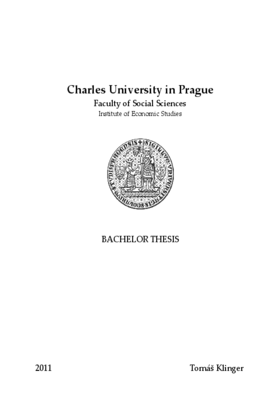Banking Regulation: Assessment and Simulation of Regulatory Measures
Bankovní regulace: hodnocení a simulace regulatorních opatření
bachelor thesis (DEFENDED)

View/
Permanent link
http://hdl.handle.net/20.500.11956/36989Identifiers
Study Information System: 102222
Collections
- Kvalifikační práce [18150]
Author
Advisor
Referee
Jakubík, Petr
Faculty / Institute
Faculty of Social Sciences
Discipline
Economics
Department
Institute of Economic Studies
Date of defense
13. 6. 2011
Publisher
Univerzita Karlova, Fakulta sociálních vědLanguage
English
Grade
Excellent
Keywords (Czech)
bankovní regulace, Basilejské dohody, multiagentní modelování, systémové rizikoKeywords (English)
agent-based modelling, banking regulation, Basel Accords, systemic riskTato práce pojednává o mezinárodní bankovní regulaci, zejména pomocí požadavků na kapitálovou přiměřenost obsažených v Basilejských dohodách. V první části se zaměřujeme na důvody regulace bank a popisujeme vývoj mezinárodní bankovní regulace včetně aktuálně představených dokumentů známých jako Basel III. Hlavním závěrem této části je skutečnost, že regulace je z velké míry ovlivňována samotnými bankami a ne vždy slouží k zajištění stability finančního systému. Ve druhé části věnované modelování systémového rizika nejprve uvedeme použitou metodologii a následně zkonstruujeme multiagentní model, který umožňuje simulovat dopady negativních šoků při různých nastaveních parametrů bankovního systému a regulatorního prostředí. Naše simulace ukazují zaprvé, že dostatečná míra kapitálu je nezbytná pro zajištění systémové stability, zadruhé, že jakmile se systém octne v systémové krizi, diskreční zásahy mají jen velmi malý účinek a zatřetí poukazují na užitečnost regulace likvidity.
This thesis focuses on international banking regulation, particularly the capital adequacy requirements known as the Basel Accords. In the first part, we study the rationale for regulating the banks and describe the evolution of the Basel Accords, including the newly presented measures known as Basel III. The main conclusion of this part is that the regulation is heavily shaped by the banks themselves and does not always serve the best for protecting the financial system. In the second part dedicated to systemic risk modelling, we first introduce the used methodology and then build an agent-based model which enables us to simulate the impacts of various types of negative shocks given various settings of the banking system and the regulatory environment, including the capital and liquidity measures. Our simulations show firstly that sufficient capital buffers are crucial for systemic stability, secondly that the discretionary measures have little effect once a crisis breaks out and thirdly that liquidity measures are a relevant regulatory tool.
